Search Result
Results for "
CD4 T cells
" in MedChemExpress (MCE) Product Catalog:
| Cat. No. |
Product Name |
Target |
Research Areas |
Chemical Structure |
-
- HY-P2560
-
|
|
Arenavirus
|
Infection
Inflammation/Immunology
|
|
LCMV GP (61-80) is a peptide fragment derived from lymphocytic choriomeningitis virus (LCMV) glycoprotein (GP), and corresponds to amino acids 61-80. LCMV GP (61-80) is a specific epitope which can induce CD4 + T-cell response .
|
-
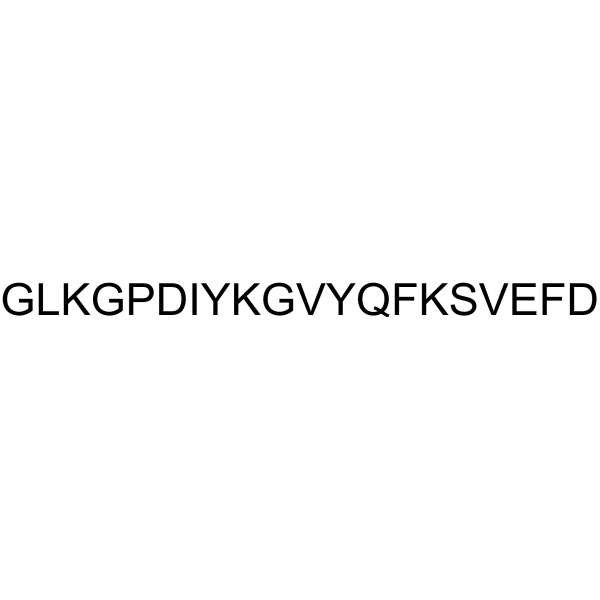
-
- HY-P9998
-
|
UB421
|
HIV
|
Cancer
|
|
Semzuvolimab is a murine IgG1κ antibody, targeting to p55, T cell surface antigen T4/Leu-3 (CD4). Murine CD4 antibodies can neutralize HIV infection and have the potential to inhibit HAART stable HIV infection .
|
-

-
- HY-P3554
-
|
|
HIV
|
Infection
|
|
Carbomethoxycarbonyl-D-Pro-D-Phe-OBzl (compound (CPF(LL)) is an HIV-1 inhibitor. Carbomethoxycarbonyl-D-Pro-D-Phe-OBzl interacts with gp120 to block gp120 binding to CD4 and preserve CD4-dependent T cell function .
|
-
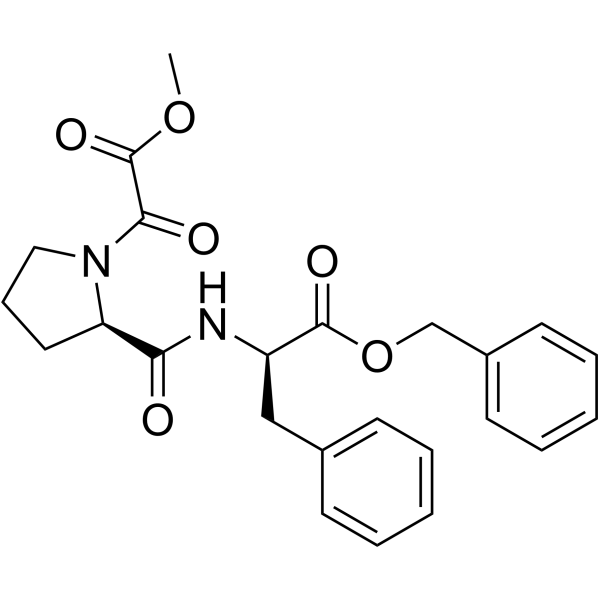
-
- HY-P2561
-
|
|
Influenza Virus
|
Infection
Inflammation/Immunology
|
|
Influenza Matrix Protein (61-72) is a peptide fragment derived from matrix protein of influenza viruses, corresponds to amino acids 61-72. Influenza Matrix Protein (61-72) is a specific epitope which can induce CD4 + T-cell response .
|
-

-
- HY-P99680
-
|
SB-210396; IDEC CE9.1
|
Interleukin Related
|
Cancer
|
|
Keliximab (SB-210396) is a chimeric human/macaque IgG1 anti-CD4 monoclonal antibody with a Ki value of 1.0 nM for soluble CD4. Keliximab blocks T cell proliferation and inhibits IL-2 production. Keliximab can be used for cancer research .
|
-

-
- HY-15440
-
|
BMS-626529
|
HIV
|
Infection
|
|
Temsavir (BMS-626529) is a novel attachment inhibitor that targets HIV-1 gp120 and prevents its binding to CD4 + T cells.
|
-
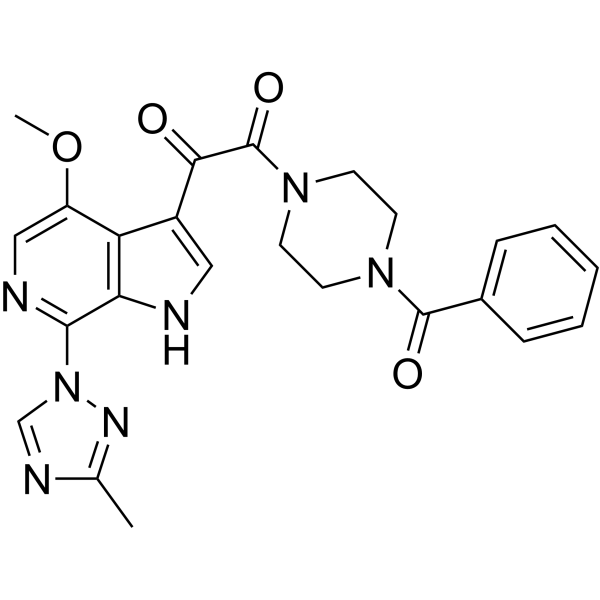
-
- HY-P5930
-
|
MDM2 32-46
|
Ligands for E3 Ligase
|
Cancer
|
|
HOXB7 8–25 (MDM2 32-46) is an MDM2-derived peptide epitope and can elicit antigen-specifc and tumor-reactive CD4 + T cell responses .
|
-
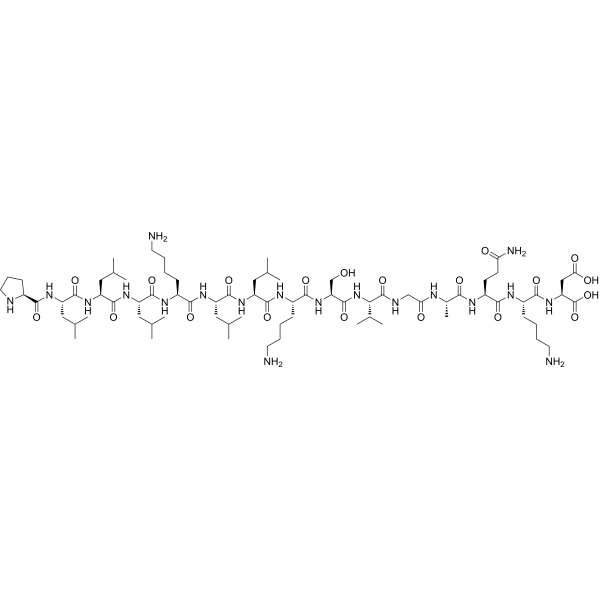
-
- HY-15440A
-
|
BMS-663068
|
HIV
|
Infection
|
|
Fostemsavir (BMS-663068) is the phosphonooxymethyl prodrug of BMS-626529. Fostemsavir (BMS-663068) is a novel attachment inhibitor that targets HIV-1 gp120 and prevents its binding to CD4 + T cells.
|
-

-
- HY-119347
-
|
|
IFNAR
STAT
|
Inflammation/Immunology
Cancer
|
|
Cirsilineol, a natural flavone compound, selectively inhibits IFN-γ/STAT1/T-bet signaling in intestinal CD4 + T cells. Cirsilineol has potent immunosuppressive and anti-tumor properties. Cirsilineol significantly ameliorates trinitro-benzene sulfonic acid (TNBS)-induced T-cell-mediated experimental colitis in mice .
|
-
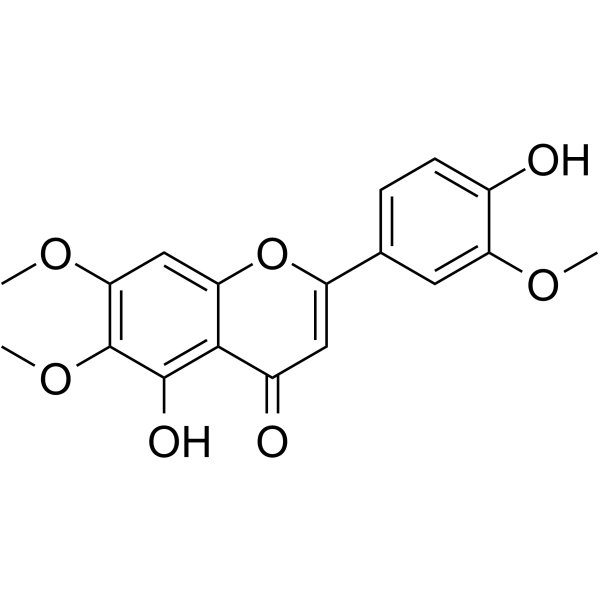
-
- HY-15440B
-
|
BMS-663068 Tris
|
HIV
|
Infection
|
|
Fostemsavir Tris (BMS-663068 (Tris)) is the phosphonooxymethyl proagent of BMS-626529. Fostemsavir Tris (BMS-663068 (Tris)) is a novel attachment inhibitor that targets HIV-1 gp120 and prevents its binding to CD4 + T cells.
|
-

-
- HY-139780
-
|
|
ROR
|
Inflammation/Immunology
|
|
JNJ-61803534 is a potent and orally active RORγt inverse agonist with an IC50 of 9.6 nM. JNJ-61803534 has anti-inflammatory activity. JNJ-61803534 inhibits IL-17A production in human CD4+ T cells under Th17 differentiation conditions .
|
-
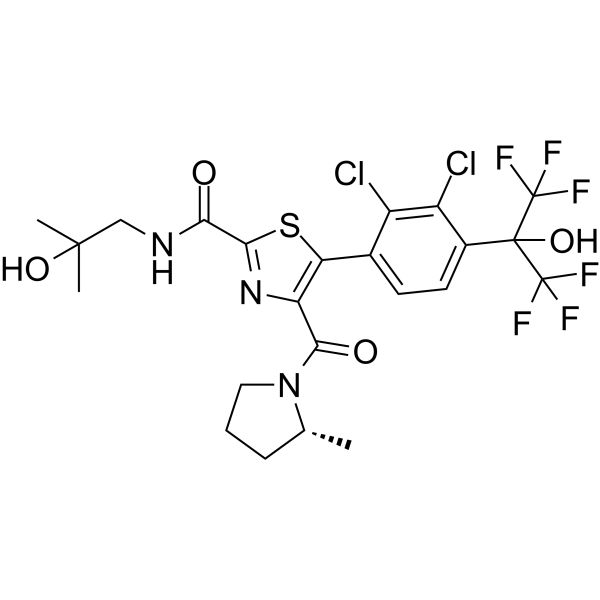
-
- HY-126037
-
|
|
ROR
|
Inflammation/Immunology
|
|
(±)-ML 209 (compound 4n), a diphenylpropanamide, is a retinoic acid-related orphan receptor RORγ antagonist with an IC50 of 1.1 μM. (±)-ML 209 inhibits RORγt transcriptional activity with an IC50 of 300 nM in HEK293t cells. (±)-ML 209 inhibits the transcriptional activity of RORγt, but not RORα in cells. (±)-ML 209 selectively inhibits murine Th17 cell differentiation without affecting the differentiation of naïve CD4 + T cells into other lineages, including Th1 and regulatory T cells .
|
-
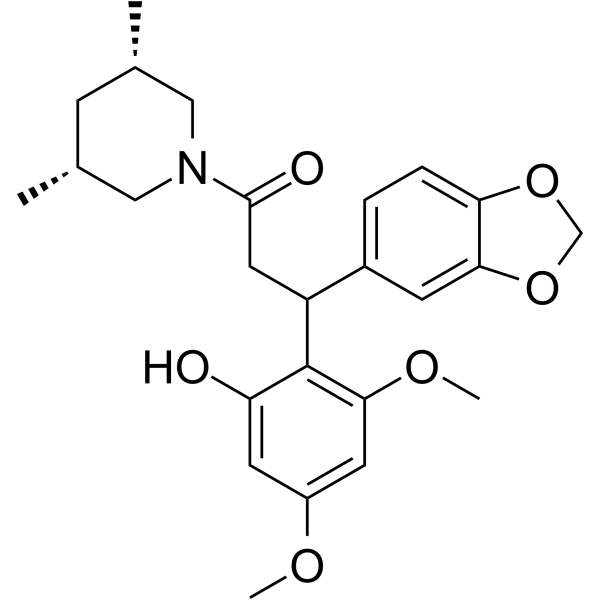
-
- HY-105037
-
|
IPP-201101
|
Autophagy
|
Inflammation/Immunology
|
|
Forigerimod (IPP-201101) is a CD4 T-cell modulator. Forigerimod is a 21-amino-acid fragment of U1 small nuclear ribonucleoprotein 70 kDa that is phosphorylated at Ser140. Forigerimod can potently inhibit autophagy. Forigerimod can be used for the research of autoimmune disorders, such as systemic lupus erythematosus (SLE) .
|
-

-
- HY-155978
-
|
|
Others
|
Inflammation/Immunology
|
|
RDN2150 (Compound 25) is a ZAP-70 inhibitor (IC50: 14.6 nM). RDN2150 covalently binds to the C346 residue of ZAP-70. RDN2150 inhibits the expression of CD25 and CD69, and inhibits CD4 + T cell activation. RDN2150 can be used for research of psoriasis .
|
-
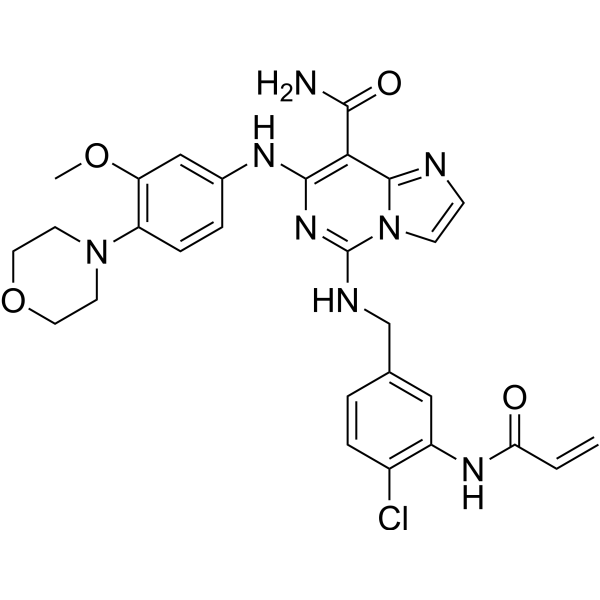
-
- HY-105037A
-
|
IPP-201101 TFA
|
Autophagy
|
Inflammation/Immunology
|
|
Forigerimod TFA (IPP-201101 TFA) is a CD4 T-cell modulator. Forigerimod TFA is a 21-amino-acid fragment of U1 small nuclear ribonucleoprotein 70 kDa that is phosphorylated at Ser140. Forigerimod TFA can potently inhibit autophagy. Forigerimod can be used for the research of autoimmune disorders, such as systemic lupus erythematosus (SLE) .
|
-
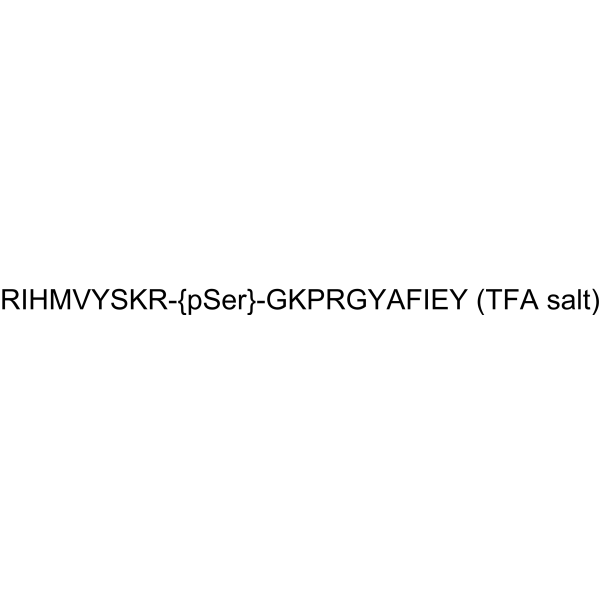
-
- HY-155978A
-
|
|
Others
|
Inflammation/Immunology
|
|
RDN2150 (Compound 25) TFA is a ZAP-70 inhibitor (IC50: 14.6 nM). RDN2150 TFA covalently binds to the C346 residue of ZAP-70. RDN2150 TFA inhibits the expression of CD25 and CD69, and inhibits CD4 + T cell activation. RDN2150 TFA can be used for research of psoriasis .
|
-
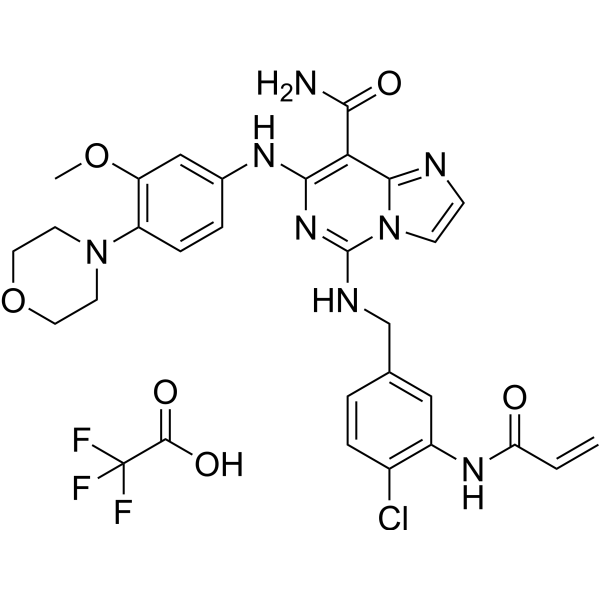
-
- HY-137618B
-
|
|
Others
|
Others
|
|
Rp-dGTPαS is the nucleotide substrate of SAMHD1 and is one of the enantiomers of the dNTPαS nucleotide. SAMHD1 is an essential regulator of cellular dNTPs that limits virus (HIV-1, etc.) replication in the CD4+ myeloid lineage and resting T cells. The SAMHD1 tetrameric complex catalyzes the hydrolysis of Rp-dGTPαS into 2'-deoxynucleosides and triphosphates .
|
-

-
- HY-145491
-
|
|
ERK
NF-κB
|
Inflammation/Immunology
|
|
Resolvin D5 is a prolytic mediator (SPM) with anti-inflammatory activity derived from oxidized lipids DHA. Resolvin D5 inhibits Th17 cell differentiation and promotes regulatory T cell differentiation, and inhibits CD4+ T cell proliferation. Resolvin D5 attenuates osteoclast differentiation and interferes with osteoclastogenesis. Resolvin D5 also regulates ERK phosphorylation and nuclear translocation of NF-kappaB. Resolvin D5 could be used in rheumatoid arthritis research .
|
-

-
- HY-157793
-
|
|
Toll-like Receptor (TLR)
NF-κB
MAPKAPK2 (MK2)
|
Inflammation/Immunology
Cancer
|
|
SMU-L11 is a specific TLR7 agonist (EC50=0.024 μM), which recruits MyD88 adapter protein and activates downstream NF-κB and MAPK signaling pathways. In murine models, SMU-L11 significantly enhances immune cell activation and promotes the proliferation of CD4 + T and CD8 + T cells, thereby directly killing tumor cells and inhibiting tumor growth. SMU-L11 can be used for cancer research, and also has the potential for studying immune system diseases .
|
-

-
- HY-161255
-
|
|
NO Synthase
|
Inflammation/Immunology
|
|
3,4-DAA is an orally active Anthranilic acid derivative with potent immunosuppressive activities. 3, 4-DAA can alleviate the severity of colitis through inhibiting Th1 cells response, promoting Th2 cytokines expression and inducing CD4 +CD25 + T cells expression . 3,4-DAA suppressed expression of inducible nitric oxide synthase (iNOS) and nitric oxide (NO) release from EOC20 cells induced by IFN-γ and Lipopolysaccharide .
|
-

-
- HY-N10295
-
|
|
Aryl Hydrocarbon Receptor
|
Inflammation/Immunology
|
|
Flavipin is an aryl hydrocarbon receptor (Ahr) agonist that induces the expression of Ahr downstream genes in mouse CD4 + T cells and CD11b + macrophages. Flavipin inhibits the stabilizing function of Arid5a on Il23a 3′UTR, a newly identified target mRNA . Flavipin exhibits the DPPH free radical scavenging ability with IC50 value of 7.2 μM, and has potent α-glucosidase inhibition with IC50 value of 33.8 μM .
|
-
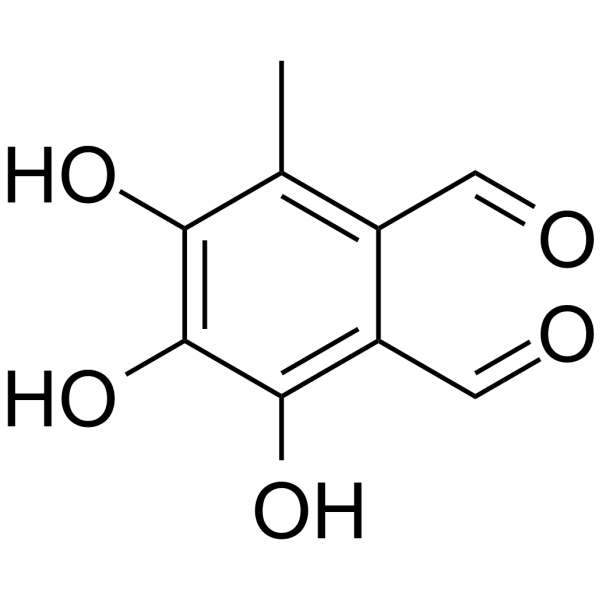
-
- HY-P1997
-
|
Desferrichrome; DFC; N-Desferriferrichrome
|
Biochemical Assay Reagents
|
Others
|
|
Ferrichrome is a hydroxamate siderophore produced by various fungi, including U. sphaerogena, that facilitates iron chelation and uptake by these organisms. It can be used as a heterosiderophore by bacteria, including Pseudomonas aeruginosa and Vibrio parahaemolyticus. Ferrichrome (0.8 μM) inhibits concanavalin A-induced proliferation of mouse spleen monocytes and reduces the number of concanavalin A-stimulated CD4+ T cells expressing IL-2 receptor. It also inhibits the heme-catalyzed oxidation of LDL by hydrogen peroxide in a concentration-dependent manner.
|
-
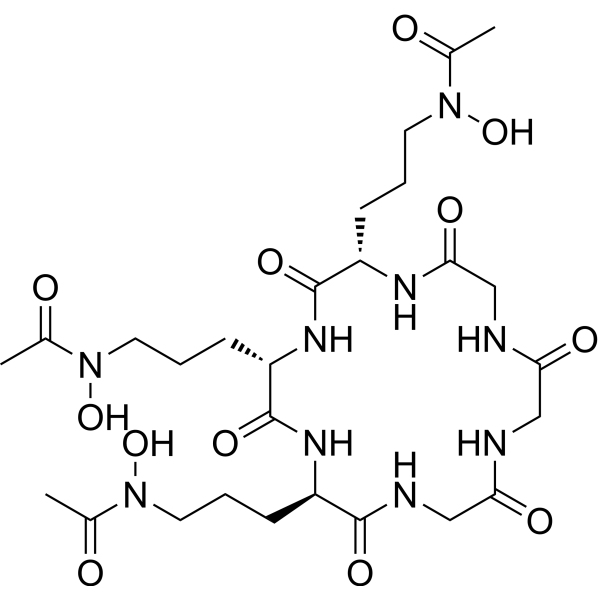
-
- HY-144746
-
|
|
PD-1/PD-L1
|
Cancer
|
|
PD-1/PD-L1-IN-26 (Compound II-14) is a potent inhibitor of PD-1/PD-L1 with an IC50 of 0.0380 μM. PD-1/PD-L1-IN-26 activates the immune microenvironment by promoting the infiltration of CD4+ T cells into tumor tissues. PD-1/PD-L1-IN-26 has the potential for the research of cancer diseases .
|
-

-
- HY-150741
-
|
|
Toll-like Receptor (TLR)
IFNAR
Interleukin Related
|
Infection
Inflammation/Immunology
Cancer
|
|
ODN 2216 is a human-specific TLR9 (toll-like receptor 9) ligand or agonist. ODN 2216 induces high amounts of IFN-α and IFN-β. ODN 2216 induces IFN-α by pDC (plasmacytoid DC) and IL-12 (p40) production by DC (dendritic cells). ODN 2216 stimulates IFN-γ production in peripheral blood mononuclear cells (PBMC), which is indirect and mediated by IFN-α/β. ODN 2216 can activate NK cells and promote IFN-γ production of TCR-triggered CD4 + T cells .
|
-

-
- HY-150741C
-
|
|
Toll-like Receptor (TLR)
|
Cancer
|
|
ODN?2216 sodium is a human-specific TLR9 (toll-like receptor 9) ligand or agonist. ODN?2216 sodium induces high amounts of IFN-α and IFN-β. ODN 2216 sodium induces IFN-α by pDC (plasmacytoid DC) and IL-12 (p40) production by DC (dendritic cells). ODN 2216 sodium stimulates IFN-γ production in peripheral blood mononuclear cells (PBMC), which is indirect and mediated by IFN-α/β. ODN 2216 sodium can activate NK cells and promote IFN-γ production of TCR-triggered CD4 + T cells .
|
-
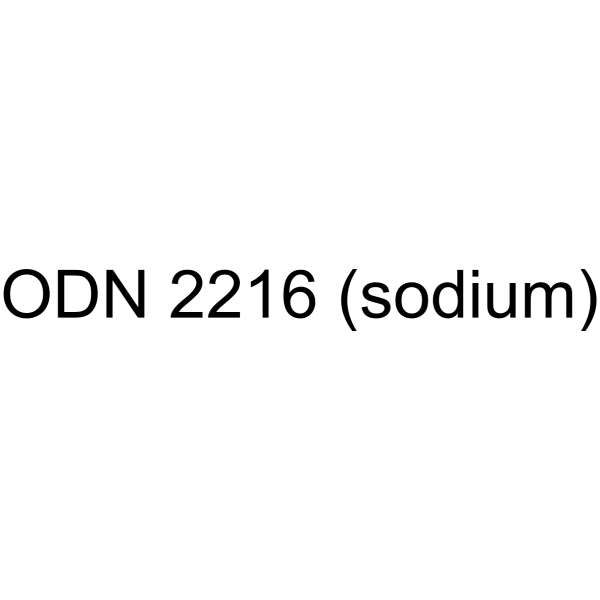
-
- HY-15898
-
Y-320
3 Publications Verification
|
Interleukin Related
Apoptosis
|
Inflammation/Immunology
Cancer
|
|
Y-320 is a potent, orally active phenylpyrazoleanilide immunomodulator. Y-320 inhibits IL-17 production by CD4 T cells stimulated with IL-15 with IC50 values of 20 to 60 nM. Y-320 enhances TP53, DMD, and COL17A1 PTC readthrough by G418 and increases cellular protein levels and protein synthesis. Y-320 concomitants use of with a low dose of Paclitaxel (HY-B0015) significantly sensitized multidrug resistance (MDR) tumors by inducing G2/M phase arrest and apoptosis. Y-320 can be used for research of rheumatoid arthritis (RA) and cancer .
|
-

-
- HY-P99222
-
|
MGA-031; PRV-031
|
CD3
|
Metabolic Disease
|
|
Teplizumab (MGA-031) is a Fc receptor non-binding anti-human CD3 monoclonal antibody. Teplizumab reduces the loss of beta-cell function. Teplizumab can be used in the research of type 1 diabetes .
|
-
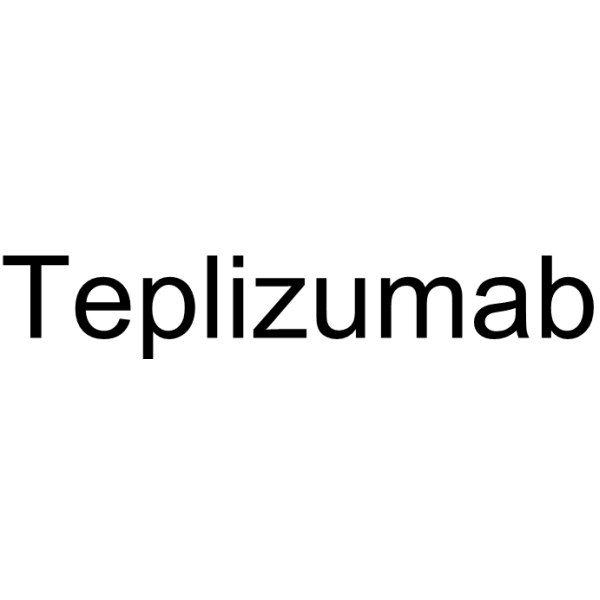
-
- HY-B0689
-
|
MK-639 free base; L-735524 free base
|
HIV
HIV Protease
Apoptosis
MMP
SARS-CoV
|
Inflammation/Immunology
Cancer
|
|
Indinavir (MK-639 free base) is an orally active and selective HIV-1 protease inhibitor with a Ki of 0.54 nM for PR. Indinavir exhibits anticancer activity by inhibiting the activation of MMPs-2 hydrolysis, anti-angiogenesis and inducing apoptosis. Indinavir is also a SARS-CoV 3CL pro inhibitor .
|
-
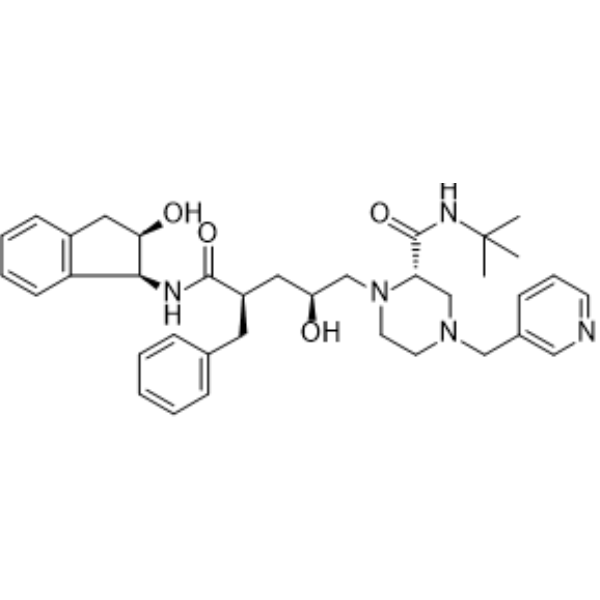
-
- HY-B0689A
-
|
MK-639; L735524
|
HIV
HIV Protease
SARS-CoV
Apoptosis
MMP
|
Infection
Cancer
|
|
Indinavir sulfate (MK-639) is an orally active and selective HIV-1 protease inhibitor with a Ki of 0.54 nM for PR. Indinavir sulfate exhibits anticancer activity by inhibiting the activation of MMPs-2 hydrolysis, anti-angiogenesis and inducing apoptosis. Indinavir sulfate is also a SARS-CoV 3CL pro inhibitor .
|
-
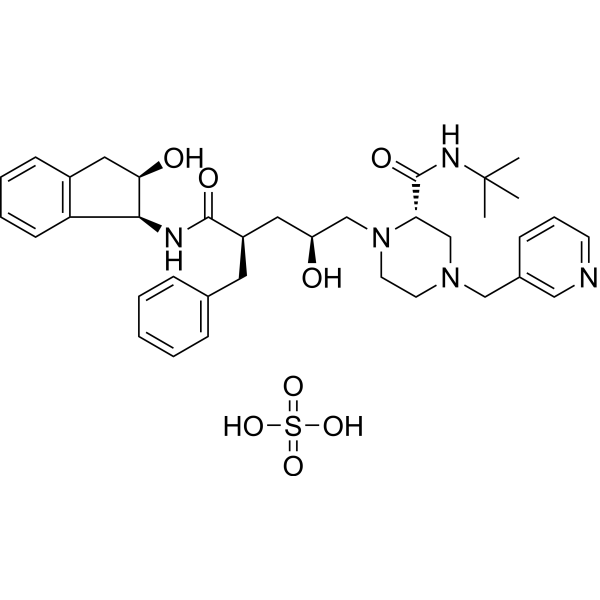
-
- HY-B0689B
-
|
MK-639 ethanolate; L735524 ethanolate
|
Apoptosis
MMP
HIV
HIV Protease
SARS-CoV
|
Infection
Cancer
|
|
Indinavir sulfate ethanolate (MK-639 ethanolate) is an orally active and selective HIV-1 protease inhibitor with a Ki of 0.54 nM for PR. Indinavir sulfate ethanolate exhibits anticancer activity by inhibiting the activation of MMPs-2 hydrolysis, anti-angiogenesis and inducing apoptosis. Indinavir sulfate ethanolate is also a SARS-CoV 3CL pro inhibitor .
|
-
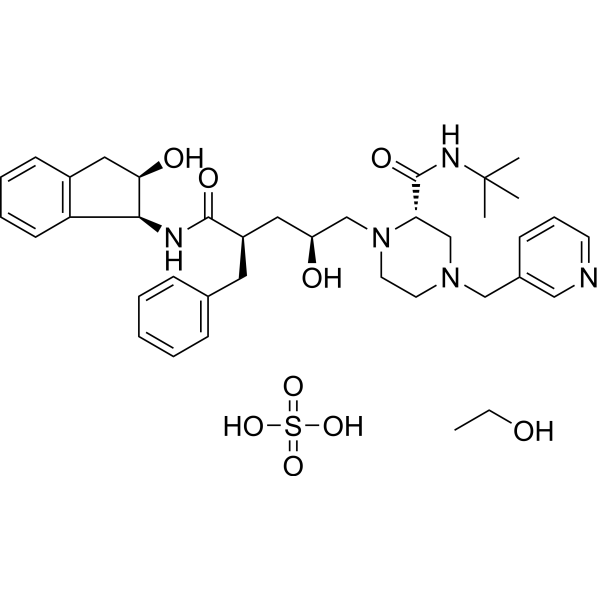
-
- HY-124750
-
-
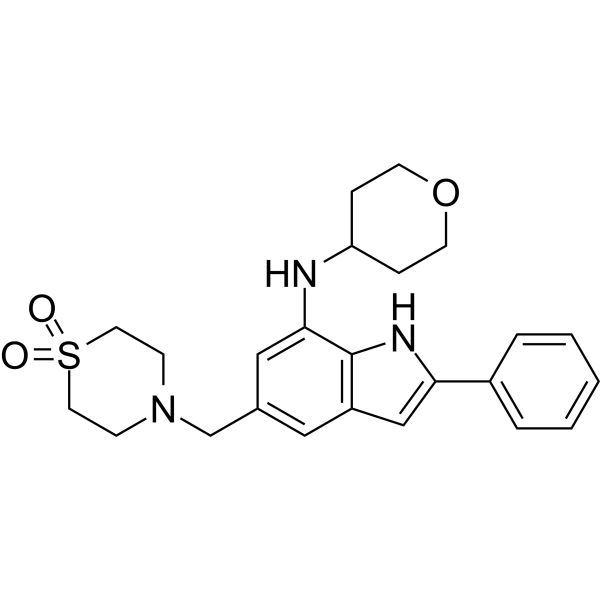
| Cat. No. |
Product Name |
Target |
Research Area |
-
- HY-P3719
-
|
|
Peptides
|
Inflammation/Immunology
|
|
MOG peptide (35-55) is a fragment 35-55 of myelin oligodendrocyte glycoprotein (MOG) immunogenic peptide. MOG peptide (35-55) is specific to expanded CD4 + T cells, and induces experimental autoimmune encephalomyelitis (EAE) in animal model .
|
-
- HY-P2560
-
|
|
Arenavirus
|
Infection
Inflammation/Immunology
|
|
LCMV GP (61-80) is a peptide fragment derived from lymphocytic choriomeningitis virus (LCMV) glycoprotein (GP), and corresponds to amino acids 61-80. LCMV GP (61-80) is a specific epitope which can induce CD4 + T-cell response .
|
-
- HY-P3554
-
|
|
HIV
|
Infection
|
|
Carbomethoxycarbonyl-D-Pro-D-Phe-OBzl (compound (CPF(LL)) is an HIV-1 inhibitor. Carbomethoxycarbonyl-D-Pro-D-Phe-OBzl interacts with gp120 to block gp120 binding to CD4 and preserve CD4-dependent T cell function .
|
-
- HY-P2561
-
|
|
Influenza Virus
|
Infection
Inflammation/Immunology
|
|
Influenza Matrix Protein (61-72) is a peptide fragment derived from matrix protein of influenza viruses, corresponds to amino acids 61-72. Influenza Matrix Protein (61-72) is a specific epitope which can induce CD4 + T-cell response .
|
-
- HY-P5425
-
|
|
Peptides
|
Others
|
|
Tetanus Toxin (830–844) is a biological active peptide. (tetanus toxin-derived peptide TT830–844 CD4+ T-cell epitope. This promiscuous CD4+ T-cell epitope can bind to a wide range of HLA–DRB molecules and is thus expected to activate CD4+ T-cell responses in a large part of the human population)
|
-
- HY-P5930
-
|
MDM2 32-46
|
Ligands for E3 Ligase
|
Cancer
|
|
HOXB7 8–25 (MDM2 32-46) is an MDM2-derived peptide epitope and can elicit antigen-specifc and tumor-reactive CD4 + T cell responses .
|
-
- HY-P5453
-
|
|
Peptides
|
Others
|
|
CFP10 (71–85) is a biological active peptide. (CFP1071–85, that elicited IFN-γ production and CTL activity by both CD4+ and CD8+ T cells from persons expressing multiple MHC class II and class I molecules)
|
-
- HY-105037
-
|
IPP-201101
|
Autophagy
|
Inflammation/Immunology
|
|
Forigerimod (IPP-201101) is a CD4 T-cell modulator. Forigerimod is a 21-amino-acid fragment of U1 small nuclear ribonucleoprotein 70 kDa that is phosphorylated at Ser140. Forigerimod can potently inhibit autophagy. Forigerimod can be used for the research of autoimmune disorders, such as systemic lupus erythematosus (SLE) .
|
-
- HY-105037A
-
|
IPP-201101 TFA
|
Autophagy
|
Inflammation/Immunology
|
|
Forigerimod TFA (IPP-201101 TFA) is a CD4 T-cell modulator. Forigerimod TFA is a 21-amino-acid fragment of U1 small nuclear ribonucleoprotein 70 kDa that is phosphorylated at Ser140. Forigerimod TFA can potently inhibit autophagy. Forigerimod can be used for the research of autoimmune disorders, such as systemic lupus erythematosus (SLE) .
|
-
- HY-P2507
-
|
|
Peptides
|
Cancer
|
|
NY-ESO-1 (87-111) is a pan-MHC class II-restricted peptide sequence. NY-ESO-1 (87-111) binds to multiple HLA-DR and HLA-DP4 molecules, and stimulates Th1-type and Th-2/Th0-type CD4 + T cells when presented in the context of HLA-DR and HLA-DP4 molecules .
|
-
- HY-P1997
-
|
Desferrichrome; DFC; N-Desferriferrichrome
|
Biochemical Assay Reagents
|
Others
|
|
Ferrichrome is a hydroxamate siderophore produced by various fungi, including U. sphaerogena, that facilitates iron chelation and uptake by these organisms. It can be used as a heterosiderophore by bacteria, including Pseudomonas aeruginosa and Vibrio parahaemolyticus. Ferrichrome (0.8 μM) inhibits concanavalin A-induced proliferation of mouse spleen monocytes and reduces the number of concanavalin A-stimulated CD4+ T cells expressing IL-2 receptor. It also inhibits the heme-catalyzed oxidation of LDL by hydrogen peroxide in a concentration-dependent manner.
|
-
- HY-K0307
-
|
|
|
MCE Mouse CD4+ T Cells Negative Selection Kit is designed for the isolation of CD4+ T cells from single cell suspensions of mouse spleen cells, lymph nodes or other tissues.
|
-
- HY-K0308
-
|
|
|
MCE Mouse CD4+ T Cells Positive Selection Kit is designed for the isolation of CD4+ cells from single cell suspensions of mouse spleen cells, lymph nodes or other tissues.
|
| Cat. No. |
Product Name |
Target |
Research Area |
-
- HY-P9998
-
|
UB421
|
HIV
|
Cancer
|
|
Semzuvolimab is a murine IgG1κ antibody, targeting to p55, T cell surface antigen T4/Leu-3 (CD4). Murine CD4 antibodies can neutralize HIV infection and have the potential to inhibit HAART stable HIV infection .
|
-
- HY-P99159
-
|
|
Inhibitory Antibodies
|
Cancer
|
|
Ivuxolimab is an OX40 (also known as CD134; TNFRSF4) agonist monoclonal antibody. OX40 is a costimulatory receptor expressed on activated CD4 + and CD8 + T cells. Ivuxolimab shows antitumor activity, with potential immunostimulatory activity .
|
-
- HY-P99790
-
|
CEN 000029; cM-T412
|
Inhibitory Antibodies
|
Inflammation/Immunology
|
|
Priliximab (CEN 000029) is an anti-CD4 humanized monoclonal antibody. Priliximab binds to CD4 on the surface of T cells, resulting in a significant and sustained reduction in circulating CD4 + T cells. Priliximab can be used in research of rheumatoid arthritis (RA) .
|
-
- HY-P99266
-
|
Anti-Human CD4 Recombinant Antibody
|
Inhibitory Antibodies
|
Inflammation/Immunology
Cancer
|
|
Zanolimumab (Anti-Human CD4 Recombinant Antibody) is a fully human monoclonal antibody targets CD4. Zanolimumab effectively inhibits T-cell receptor (TCR) signal transduction. Zanolimumab can be used for the research of heumatoid arthritis, psoriasis, melanoma, cutaneous and peripheral T-cell lymphoma .
|
-
- HY-P99680
-
|
SB-210396; IDEC CE9.1
|
Interleukin Related
|
Cancer
|
|
Keliximab (SB-210396) is a chimeric human/macaque IgG1 anti-CD4 monoclonal antibody with a Ki value of 1.0 nM for soluble CD4. Keliximab blocks T cell proliferation and inhibits IL-2 production. Keliximab can be used for cancer research .
|
-
- HY-P99327
-
|
BT-061
|
Inhibitory Antibodies
|
Inflammation/Immunology
|
|
Tregalizumab is a humanized anti-human CD4 monoclonal antibody (IgG1 type) that selectively activates the suppressive properties of regulatory T cells (Tregs) in vitro. Tregalizumab can be used in the research of autoimmune diseases (resulting from insufficient Treg activity) and allergies .
|
-
- HY-P99382
-
|
JTX 2011
|
Inhibitory Antibodies
|
Inflammation/Immunology
Cancer
|
|
Vopratelimab (JTX-2011) is a humanized immunoglobulin G1-kappa agonist monoclonal antibody that pecifically binds to the Inducible CO-Stimulator of T cells (ICOS). Vopratelimab retains species cross-reactivity with affinities of 0.93 nM to hICOS, 0.46 nM to cynomolgus ICOS, 3.7 nM to rat ICOS, and 0.64 nM to mICOS. Vopratelimab has antitumor immune response .
|
-
- HY-P99222
-
|
MGA-031; PRV-031
|
CD3
|
Metabolic Disease
|
|
Teplizumab (MGA-031) is a Fc receptor non-binding anti-human CD3 monoclonal antibody. Teplizumab reduces the loss of beta-cell function. Teplizumab can be used in the research of type 1 diabetes .
|
| Cat. No. |
Product Name |
Category |
Target |
Chemical Structure |
Your information is safe with us. * Required Fields.
Inquiry Information
- Product Name:
- Cat. No.:
- Quantity:
- MCE Japan Authorized Agent:







































